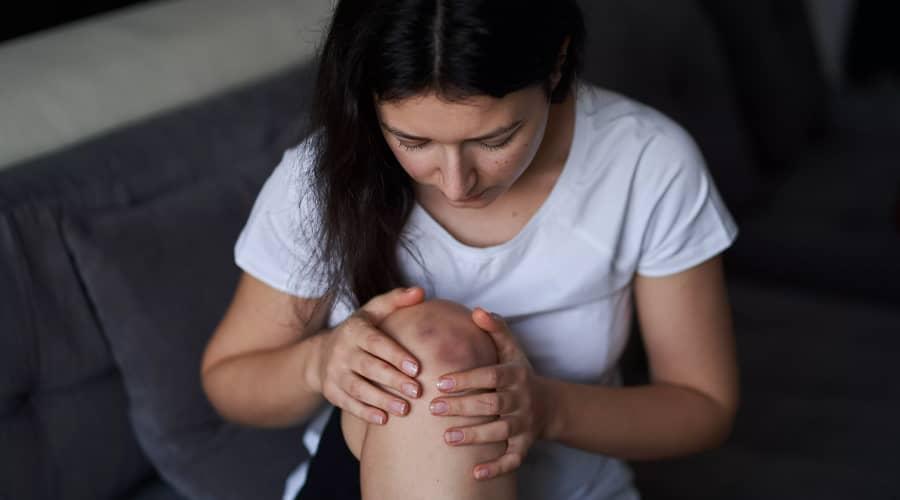
A haemorrhage is when a blood vessel is damaged and blood is released into the tissues.
There are types that may require urgent medical intervention, but the more common forms can be treated with much milder methods.
Haematoma can also occur during pregnancy or even in the cranial cavity. Bruising is the colloquial term for harmless subcutaneous haemorrhages or even blood clots that develop as a result of a blow or fall. It can occur after surgery or after a simple blood test.
The pressure on the tissues causes the small capillaries to rupture and blood is then released into the tissues. This causes the blood to stain the skin a bluish-red colour, which degrades over a few days, then turns yellowish-green and eventually disappears completely, but this can take several weeks. Unfortunately, hematomas can also cause swelling and swelling on pressure.
However, the good news is that there are several natural solutions and herbal remedies for haematoma.
Let’s also look at how to treat hematoma naturally!
The first herb to be mentioned is the plum-leaved bangita. This is a low-growing tree from the United States. It is also used internally for bruising, skin haemorrhages and to strengthen the capillaries of the skin. In addition to treating haematomas, it is also recommended for use against circulatory insufficiency and haemorrhoids. It is very good against spasms due to gynaecological causes and to relieve menstrual pains.
Next is fennel essential oil which also speeds up the healing of bruising. It has very good antibacterial, circulatory and anti-inflammatory properties. Can be used very widely as toothpastes, mouthwashes, but also in skin and hand creams. It is also used for indigestion and coughs.
Treatment of a clotted haematoma
A clotted hematoma, also known as a haematoma, is a condition in which blood pools in one place and forms a fibrous tissue (capsule) around it. It often develops after trauma or injury, when blood cannot be absorbed properly. The treatment of an ingrowing hematoma aims to relieve pain, prevent infection and restore function.
Rest, ice, compression and elevation of the limb (RICE method) are recommended to reduce swelling and pain.
If the hematoma is large or painful, medical intervention may be necessary.
How long does it take for the hematoma to be absorbed after surgery?
A postoperative haematoma, also known as a postoperative haematoma, is the accumulation of blood in the surgical area due to vascular damage caused during the operation. Such haematomas can vary in size and the time it takes for them to be absorbed depends on a number of factors, including the size of the haematoma, the general health of the patient, and the area of surgery and its blood supply.
Minor haematomas: These often disappear in 2-4 weeks. These bruises usually cause few symptoms and do not require any special intervention.
Larger haematomas: These can take up to 6-8 weeks or longer to resolve. Such hematomas are more likely to cause pain and swelling and sometimes require medical intervention.
Complicated cases: If the hematoma becomes infected or does not absorb properly, surgical removal may be necessary. In these cases, the healing time may be longer.
Bruising can also be treated with cream.
In folk medicine, the herb called black coneflower is also known as mullein. It can be made into tinctures, ointments and essences. It is not recommended for internal use as it can damage the liver. Externally, however, it can be great for ulcers, burns and bruises. It can also be great for arthritis, rheumatism and to soothe sprains. If you would like to experience the wonderful effects of black carnation yourself, try HillVital Black Comfrey Balm. There are several other ways to treat haematoma at home. After an effective treatment, hematoma absorption is almost certain.
There are other natural methods besides herbal remedies. Treatment of haematoma at home is also possible with the help of a vinegar water poultice. The swelling will subside and thus the pain will be relieved. Just mix 100 ml of cold water with 50 ml of vinegar. Soak a cloth in it and apply it on the hematoma.
The gel found in aloe vera leaves can also help a lot with the discomfort. It has been used for thousands of years for similar problems. To treat haematoma, just apply the gel to the problem area several times a day.
St. John’s wort oil is also an oil available in pharmacies that if you rub it on the painful area daily, it can help to relieve it.
Mild bruising will go away on its own in a few weeks, use these methods if you want to have no trace of the bruise in a few days.
Treatment of bruising after blood sampling is usually simple and can be done at home.
Cold compress: you can immediately apply a cold compress to the damaged area. You can use ice gel, a cooling bag or even a bag that you have frozen and then wrap a thin cloth or towel around it so that it is not in direct contact with the skin. The cold can help reduce swelling and bruising.
Rest and elevation: If the bruise is on your leg or arm, lie down and elevate the injured part of your body supported by a pillow or other object. This will help reduce swelling and pain.
Compression bandage:. If the bruising affects a larger area or you feel that the swelling will persist, you can use a compression bandage on the injured area. Compression helps to control blood flow and reduce swelling.
Time: Time is the best healer. Bruising usually goes away on its own in a few days. It is important to give the injured area enough rest to allow the body to process and heal the affected area.
What are the best hematoma absorbing creams?
For hematomas or bruises, there are a number of creams and ointments containing herbal ingredients that can help with absorption and healing.
Let’s look at the herbal ingredients that can help:
Arnica: Arnica is an herb that is often used to treat bruises and injuries. Creams containing arnica extracts can help reduce swelling and improve circulation.
Borage oil:. The gamma linolenic acid (GLA) found in borage oil can help reduce inflammation and promote skin regeneration.
Chamomile:. Chamomile creams are known for their anti-inflammatory and soothing properties, which can help to heal the skin.
Calendula: Calendula creams can be useful for bruises due to their anti-inflammatory and wound healing properties.



